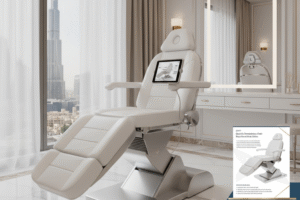
Best Oxygeneo Machine in the UAE: GeneO+ 3 in 1 Facial Device
In today’s competitive aesthetic market, dermatology clinics and skincare centers across the UAE need more than just skilled professionals; they
More Posts

In today’s competitive aesthetic market, dermatology clinics and skincare centers across the UAE need more than just skilled professionals; they

In a busy dermatology clinic, the right chair can make all the difference in efficiency, comfort, and treatment outcomes. Yet
Send Us A Message
High speed dental handpieces are incredibly versatile tools utilized in countless procedures across all disciplines of dentistry. Undoubtedly, they stand among the most essential instruments in any dental professional’s toolkit.
As the demand for precision and efficiency in clinical procedures continues to grow, understanding the mechanisms, functions, and maintenance of these tools is no longer optional—it's essential.
At Skyline Medical, we recognize how critical it is for dentists and clinicians to choose equipment that delivers lasting performance. That’s why we provide access to a curated selection of FDA-cleared, sterilization-safe, and UAE-compliant high-speed handpieces, exclusively from reputable global brands such as NSK and COXO.
To support your purchasing decisions and daily clinical use, we’ve prepared this in-depth guide that answers the most important questions about high-speed handpieces.
A dental handpiece—often referred to as a dental drill—is a precision-engineered tool that uses a rapidly rotating bur to remove tooth tissue, typically in preparation for fillings, crowns, or other restorations. A handpiece is classified as “high-speed” if it operates within a speed range of approximately 300,000 to 450,000 revolutions per minute (RPM).
These handpieces are typically powered by:
🔍 Market Breakdown:
High-speed handpieces share several essential components:
There are various models of high-speed handpieces, which differ by:
Skyline Medical offers a variety of dental handpieces designed to meet various clinical requirements and dentist preferences, while maintaining strict compliance with international medical device standards.

Material choice directly impacts a handpiece’s performance and longevity. For example, titanium is significantly more corrosion-resistant and lightweight than stainless steel, which in turn outperforms brass in structural integrity and sterilization tolerance.
In air-driven Handpiece models, pressurized air is delivered through the dental chair’s foot control pedal and into the tubing connected to the back of the handpiece. Once the air reaches the turbine chamber, it spins the impeller blades, causing the bur to rotate at extremely high speeds. The spent air is then expelled through an exhaust port.
🛠️ Mechanical Principle:
Here’s where the relationship between head size, turbine size, and torque comes into play:
| Head Size | Turbine Size | RPM | Torque (Power) |
|---|---|---|---|
| Small | Compact | Higher | Lower |
| Large | Wider Impeller | Lower | Higher |
This means a high-speed handpiece with a larger turbine may spin slower than a smaller counterpart but will deliver greater torque—making it more efficient at cutting hard enamel or dense materials without bogging down.
To reduce the frictional heat caused by this high-speed rotation, modern handpieces incorporate:
The design of high-speed handpieces allows for clean, rapid, and accurate removal of hard dental tissues and restorative materials. Some of the most common clinical applications include:
Because they minimize vibration and are ergonomically balanced, these handpieces offer superior tactile sensitivity, improving control and reducing operator fatigue.
At Skyline Medical, we match each handpiece’s specifications with your intended use—whether it’s pediatric cavity prep with a mini-head model, or crown sectioning with a high-torque turbine.
Both High-Speed and Low-Speed Dental Handpieces are critical in dental procedures, but also they differ significantly in design, function, and clinical purpose as the table shows:
| Attribute | High-Speed Handpiece | Low-Speed Handpiece |
|---|---|---|
| Speed | 300,000–450,000 RPM | 5,000–40,000 RPM |
| Power Source | Air / Electric | Air / Electric |
| Torque | Moderate | High (at low speeds) |
| Noise Level | Higher | Quieter |
| Clinical Use | Cutting enamel/dentin, crown prep, sectioning | Polishing, finishing, caries excavation, endodontics |

Many dentists use both handpieces sequentially. For example, a high-speed handpiece is used for gross cutting, while the low-speed is used for smoothing margins or refining the prep.
High-speed handpieces operate at rotational speeds ranging from 300,000 to 450,000 RPM, depending on the air pressure applied and the turbine's internal configuration, including the bearings, impeller blade design, and chuck system.
For example, at a stable air pressure of around 0.22 MPa (approximately 31.9 PSI), a high-performance turbine handpiece CHIRANA TGL 637A, can reach a free speed of approximately 380,000 RPM ±10%.
It’s essential to differentiate between:
⚙️ Additionally, torque is not linear with speed:
This is why some dental high speed handpiece models, though slightly slower, outperform faster competitors in cutting dense enamel or ceramic restorations.
According to recent clinical evaluations a high-quality handpiece can typically withstand around 500 sterilization cycles—translating to roughly 12 months of active clinical use under normal load conditions.
Generally, The longevity of a dental handpiece depends on:
The longevity of a handpiece is not just about the outer shell; the integrity of the turbine unit, the balance of the bearings, and the compatibility of replacement parts all play a pivotal role. Using non-genuine spare parts (even for minor repairs) often results in reduced efficiency and the need for more frequent replacements.
That’s why Skyline offers certified repair kits and OEM turbines to ensure continued performance without compromising patient safety.
🛠️ Skyline Medical exclusively supplies handpieces engineered for durability, including options like: NSK Ti-Max Z900L: High-grade titanium body, ceramic bearings, excellent resistance to corrosion.
Given their critical function and cost, extending the lifespan of high-speed handpieces is a top priority for every dental practice. Fortunately, proper maintenance doesn’t require advanced skills—but it does require consistency, attention to detail, and adherence to manufacturer protocols.
This table shows General Guidelines for Handpiece Maintenance:
| Maintenance Step | Key Notes |
|---|---|
| Use proper air pressure | Exceeding manufacturer’s PSI can damage turbines. |
| Lubricate through correct port | Avoid contaminating the air drive system. |
| Purge with air for 30 seconds | Removes excess lubricant and debris. |
| Remove bur before sterilization | Prevents chuck damage. |
| Clean fiber optics gently | Avoid alcohol or abrasive materials. |
| Never use harsh chemicals | Use only approved cleaners and lubricants. |
| Store upright | Prevents turbine misalignment and bearing wear. |
👉🏻 Learn with us how to maintain and sterilize high speed dental handpiece
Purchasing a high-speed handpiece online can be convenient—but it also comes with significant risks, especially if you're not sourcing from an authorized medical distributor. When choosing the right dental handpiece, consider your specialty, frequency of use, and clinical demands—not just the promotional claims.
To avoid costly mistakes, keep the following checklist in mind:
1. FDA 510(k) Clearance:
✔ All dental handpieces should be registered as Class I medical devices.
✔ This ensures the product meets safety, sterilization, and hygiene standards.
2. Source Credibility:
✔ Avoid unknown or overseas discount platforms.
✔ Large price discrepancies (e.g., $150 vs. $1,200 for the same model) are a major red flag.
3. Technical Specifications:
✔ Compare: RPM range, Torque, Bur concentricity, Noise level, Head size, Weight and grip ergonomics, Fiber optic lighting, and Warranty coverage)
4. Brand Reputation and After-Sales Support:
✔ Does the vendor offer repair services or replacement turbines?
✔ Can you verify spare parts compatibility?
✅ At Skyline Medical, all dental handpieces are:
✔ FDA-cleared ✔ Compliant with UAE sterilization protocols
✔ Supplied directly from manufacturers ✔ Backed with service support and OEM parts
High-speed dental handpieces are far more than just mechanical tools—they are the backbone of efficient, precise, and high-quality dental care. From their intricate internal turbines to the ergonomic designs that support clinicians through long procedures, these instruments reflect the advanced engineering and clinical insight that modern dentistry demands.
But owning the right handpiece is only part of the equation. Selecting a reliable supplier, ensuring proper maintenance, and understanding the technical relationships between components are what truly ensure long-term performance and patient safety.